Home / The Hofmann and Curtius Rearrangements
Amines
The Hofmann and Curtius Rearrangements
Last updated: June 5th, 2025 |
Here’s the thing about the coverage of “amines” in Org 2: there’s no narrative.
Unlike most chapters, it doesn’t start with a set of concepts and then build up to a series of examples you can then apply those concepts to.
No. A typical chapter on amines in an introductory textbook is essentially just a hodge-podge of seemingly random topics thrown together that didn’t fit anywhere else. The only unifying thread is that they contain nitrogen in some way.
Case in point: today’s random amine post is about the Hofmann and Curtius rearrangements.
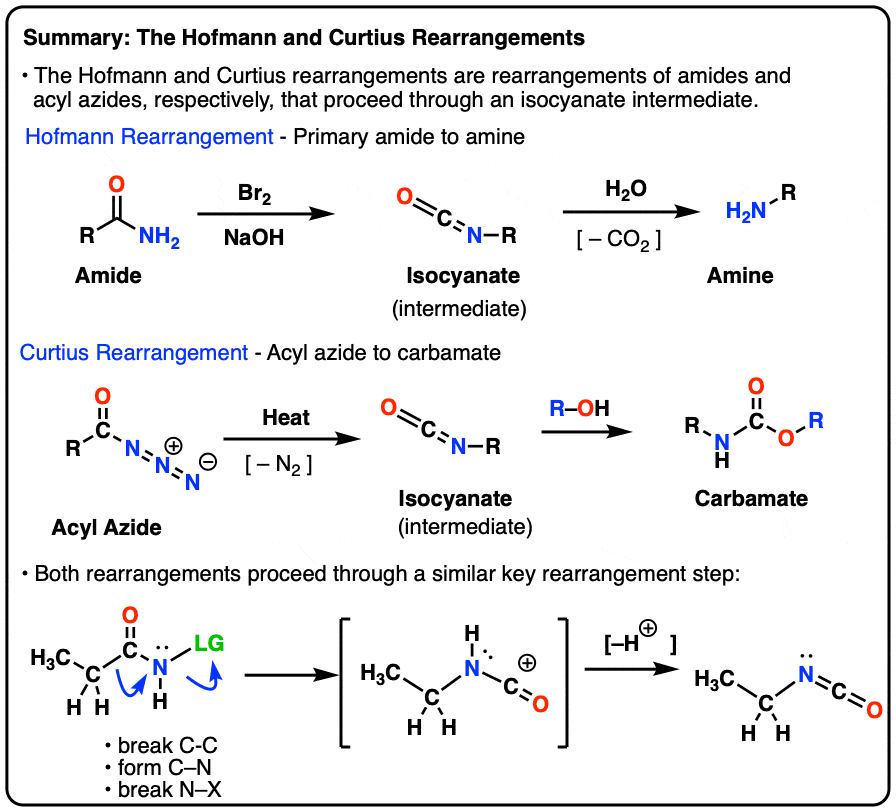
What prompts this, you might ask? No good answer. Most courses cover them at some point, and they’ve got to fit in somewhere. So what the hell. Why not now?
Table of Contents
- The Hofmann and Curtius Rearrangements
- The Mechanism of the Hofmann and Curtius Rearrangements, Part One – Setting Up The Rearrangement
- Part Two: The Key Rearrangement Step In The Hofmann And Curtius Rearrangements
- Part Three: Formation of the Isocyanate
- Putting The Steps Together
- The Fate of the Isocyanate: Formation of Carbamates, Amines, And Ureas
- Summary: The Hofmann and Curtius Rearrangements
- Notes
- Quiz Yourself!
- (Advanced) References and Further Reading
1. The Hofmann and Curtius Rearrangements
The Hofmann and Curtius rearrangements are two examples of a whole family of rearrangement reactions that share a common mechanistic step. [as do the Beckmann and Wolff rearrangements – see bonus topic 2]
In the Hofmann rearrangement, an amide is treated with bromine and base (usually NaOH or KOH). Upon heating, an intermediate isocyanate is formed, which is not isolated. In the presence of water, the isocyanate loses carbon dioxide (“decarboxylates”) to give an amine.
The key bond that forms in the Hofmann is the C2–N bond. Note how the carbonyl group (C1) is lost, forming carbon dioxide (CO2). (note: this isn’t IUPAC numbering, just numbering to facilitate discussion)

In the Curtius rearrangement, an acyl azide is heated, and an isocyanate is formed. In the Curtius, the isocyanate can be isolated, but is usually transformed further into other species such a carbamate, a urea, or (via decarboxylation, as in the Hofmann) to an amine (more on those below).

The key observation to note in both cases is that the C1-C2 bond has broken, and a new C2-N bond has formed.
The question is HOW?
2. The Mechanism of the Hofmann and Curtius Rearrangements, Part 1: Setting Up The Rearrangement
There are four important parts to the mechanism of the Curtius and Hofmann rearrangements, and we’re going to walk through them all.
- Prelude (straightforward)
- The key migration step (tricky, but less tricky if you realize you’ve seen a variant of it in Org 1 !)
- Formation of the isocyanate (straightforward)
[interlude: steps 2 and 3 actually happen at the same time, so we’ll show how to put them together]
4. Epilogue: Transformations of the isocyanate
Part 1: Prelude
- The Hofmann rearrangement occurs with an amide.
- The Curtius rearrangement occurs with an acyl azide.
Both are conveniently prepared from acyl halides through an addition-elimination reaction. If you’re covering amines now, then carbonyl reactions are likely familiar territory. The acyl halides can be prepared from carboxylic acids through using a reagent like thionyl chloride (SOCl2) or phosphorus pentachloride (PCl5).
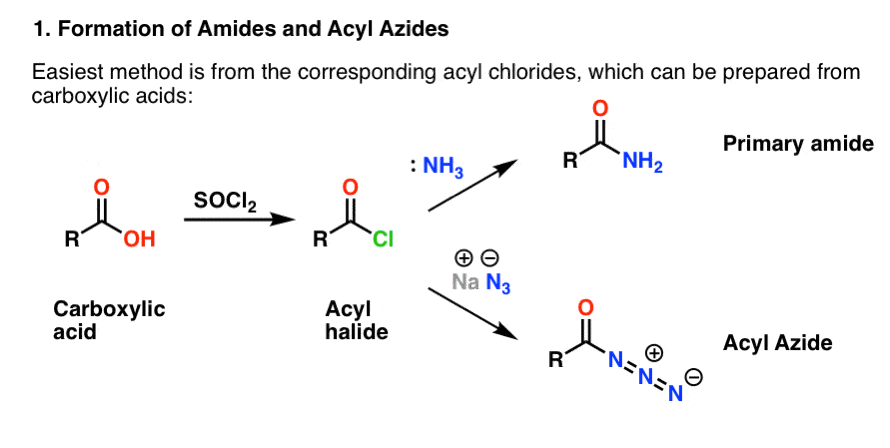
Setting up the Hofmann
In the Hofmann rearrangment, the amide is treated with bromine (Br2) and a base such as NaOH. This results in the breakage of N-H and the formation of N-Br, resulting in the installation of a good leaving group on the nitrogen. We call this an “N-bromo amide”.
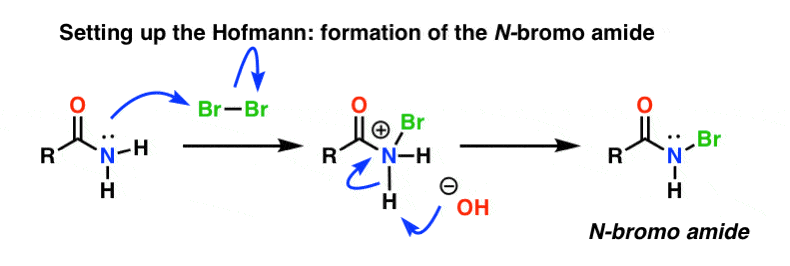
The Curtius needs no “setting up”, as the acyl azide already has a splendid built-in leaving group: N2. This is why organic azides should be treated with care, as rough treatment can lead to explosions.
3. The Key Rearrangement Step In The Hofmann and Curtius
Now we get down to business.
The key step in the Hofmann and Curtius rearrangments is migration of a carbon atom to displace a leaving group on an adjacent nitrogen.
This requires two curved arrows to draw, which are shown in the structure on the far left (below).
- In the first curved arrow, the C-C bond breaks, and a new C-N bond forms.
- In the second curved arrow, the N–LG (leaving group) bond breaks.
However, it isn’t always easy to go directly from the structure on the far left to the structure on the far right (which is drawn nice and tidy! ).
Countless points are needlessly lost in exams every year by students who get the curved arrows right but end up drawing the wrong structure! That’s why I encourage students to draw an “ugly version” first, which looks like crap but at least has all the bonds in the right place. There’s always time to redraw it and make it look pretty later.
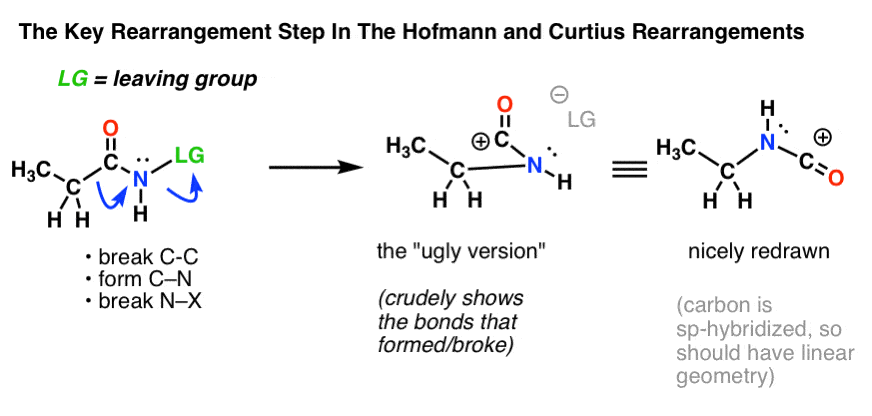
At first this rearrangement probably looks… odd. But it’s actually a reaction you’ve seen before! (but in disguised form).
Anyone remember the mechanism for the “oxidation” step in hydroboration-oxidation?
It’s basically the same thing!
Here’s a refresher:
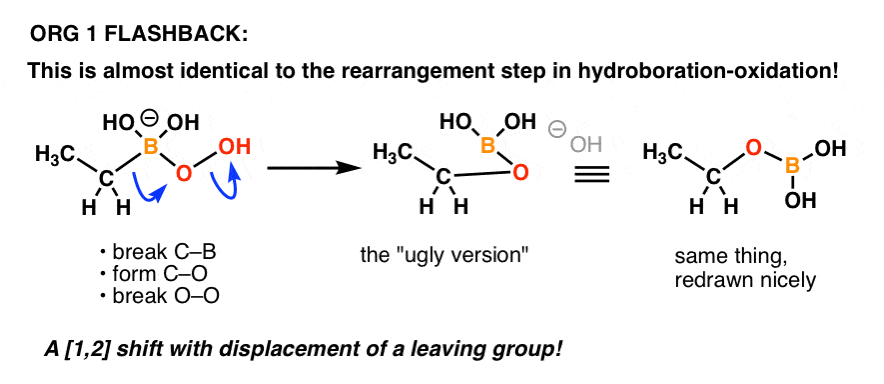
Just another example of how things you learn in an earlier part of organic chemistry can come back in a later part of the course!
Let’s visit the specific rearrangement step in the Hofmann and Curtius rearrangements with concrete examples.
Here’s the key step in the Hofmann, where heating results in breakage of C-C , formation of C-N, and breakage of N-Br.
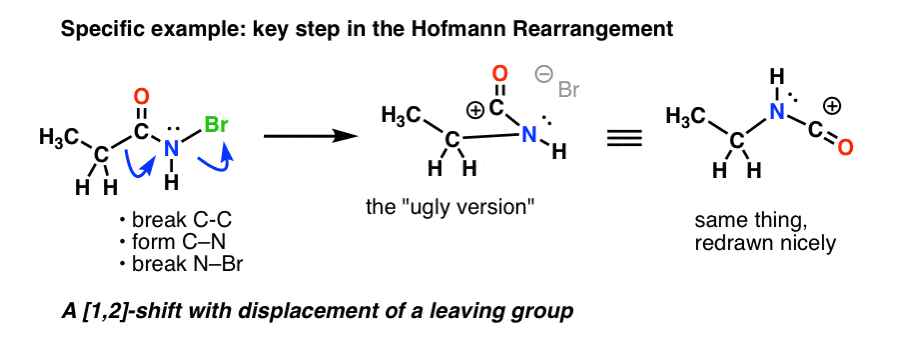
If you follow all the arrows, you should end up with a weird-looking carbocation (above right) which we’ll deal with in a minute.
In the Curtius, heating the acyl azide results in rearrangement. The leaving group is nitrogen gas (N2).
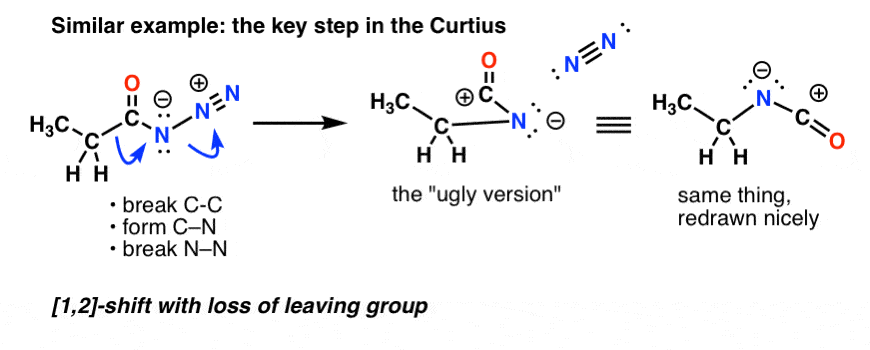
(A subtle difference between the Curtius and the Hofmann is that there is no hydrogen attached to N in the Curtius, so we end up with a negative charge on the nitrogen in the rearranged species.)
4. Formation of the Isocyanate
The next step is going from our rearranged species to the isocyanate. For anyone accustomed to drawing resonance forms, this shouldn’t be too difficult.
(As we’ll discuss below, studies have determined that isocyanate formation occurs at the same time as migration. But for our teaching purposes, I think it helps to treat this step in isolation. We can put it all together in a minute).
As you might recall from waayyyy back in Org 1, a resonance form with full octets is superior to one without (quick review). Our weird-looking product from rearrangement has a carbocation adjacent to a nitrogen containing a lone pair. So the first step is to draw the formation of a new C-N pi bond. This is essentially just a resonance form.
The Hofmann rearrangement occurs in the presence of base. So after drawing the resonance form, the next step is deprotonation of the N–H bond giving the neutral isocyanate.
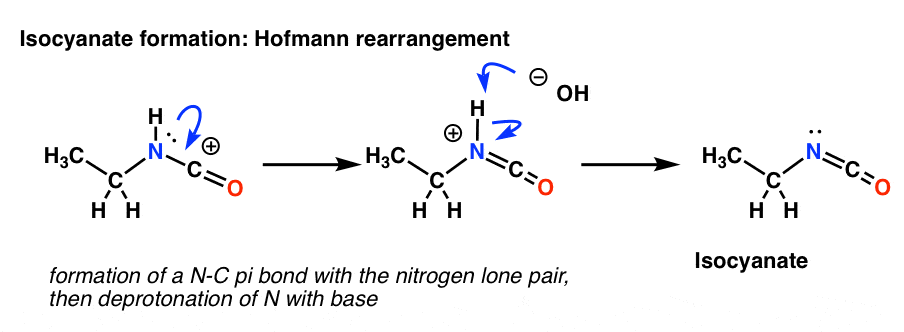
There’s no hydrogen on the nitrogen in the Curtius. So isocyanate formation is achieved merely by donation of a lone pair from nitrogen to the carbocation. You can just look at it as drawing a resonance form.
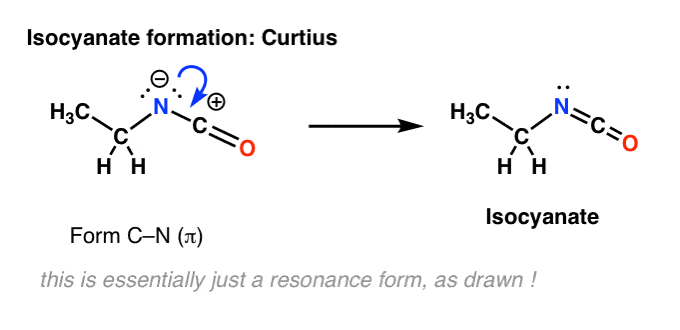
5. Putting The Steps Together
Studies into the mechanism of the Hofmann and Curtius rearrangements have determined that these two steps do not happen sequentially; they actually happen at the same time! (how do we know this? see Note 1 )
That is, the migration happens at the same time as isocyanate formation.
We need to redraw the mechanisms of the Hofmann and Curtius to reflect that, incorporating both steps.
Here’s the Hofmann (note that the deprotonation event is actually separate).
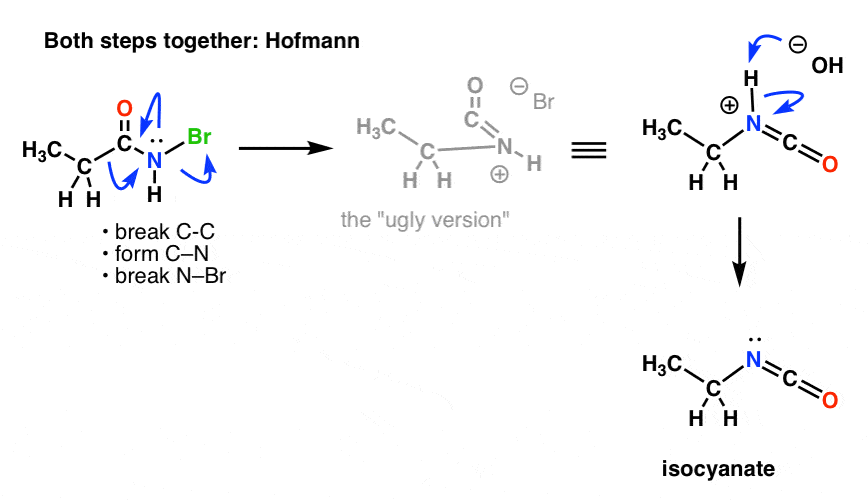
And the Curtius:

6. The Fate Of The Isocyanate
Both the Hofmann and Curtius give rise to an isocyanate. You likely haven’t encountered isocyanates before. At first glance, they are pretty strange-looking species, but their chemistry is not so different from that of other carbonyl species such as esters, amides, and acyl halides.
The isocyanate structure closely resembles that of carbon dioxide, CO2. The carbon is pi-bonded to two strongly electronegative atoms. This makes the carbon an excellent electrophile.
By adding various nucleophiles, isocyanates can be transformed into other useful species.
• Adding an alcohol results in formation of a carbamate
• Adding an amine results in a urea
• Adding water results in a carbamic acid, which is unstable. Carbamic acids quickly lose carbon dioxide to give an amine.

In particular, the decarboxylation pathway presents a nifty way to make amines. We’ve learned tons of ways to make carboxylic acids, but not too many ways of making amines (besides nucleophilic substitution and reductive amination). The Hofmann is a good trick to have in your back pocket in situations where neither of those situations might apply – like making substituted anilines, for example.
Mechanisms? See Note 2.
7. Summary: The Hofmann and Curtius Rearrangements
The mechanism of these rearrangments is tricky at first glance, but is made considerably easier once you realize that you’ve seen a variant of the migration reaction before (i.e. in hydroboration-oxidation).
I highly recommend drawing the ugly version first, because it will help you focus on seeing the bonds that form and break, before trying to redraw it into a more aesthetically appealing structure. This also goes for the Beckmann and Wolff rearrangements, which have a similar step.(see below)
Notes
Related Articles
- The Cope Elimination
- Draw The Ugly Version First
- Some Reactions of Azides
- Rearrangement Reactions (1) – Hydride Shifts
- More Reactions on the Aromatic Sidechain: Reduction of Nitro Groups and the Baeyer Villiger
- Hydroboration Oxidation of Alkenes Mechanism
- Curtius Rearrangement of Acyl Azides to Isocyanates
- Hofmann Rearrangement of Amides to Amines
- Amine Practice Questions
Note 1. Concerted or separate steps?
If the Curtius was stepwise, the loss of nitrogen would lead to a nitrene. Nitrenes undergo a host of interesting reactions, such as insertion into C-H bonds (!). So one can design an experiment to test this: if one tries the following Curtius rearrangement, one could look for evidence of formation of a five-membered ring.

The absence of such products, along with other evidence, points to a concerted mechanism.
The most important mechanism of isocyanates is electrophilic addition (i.e. adding a nucleophile to the central, electrophilic carbon). In the mechanism below I showed the nucleophile adding to the carbon so as to form an anion on the nitrogen, although this is is likely not the best resonance form (the oxygen is better at stabilizing negative charge than is nitrogen). Proton transfer from oxygen to nitrogen results in a neutral species. (I used the Magic Wand of Proton Transfer here, because it’s faster).
Note that the decarboxylation step in 1) doesn’t need to be preceded by deportation of the oxygen, although it definitely needs to occur such that nitrogen is protonated during the step (you don’t want to form a strongly basic amide ion, for instance).
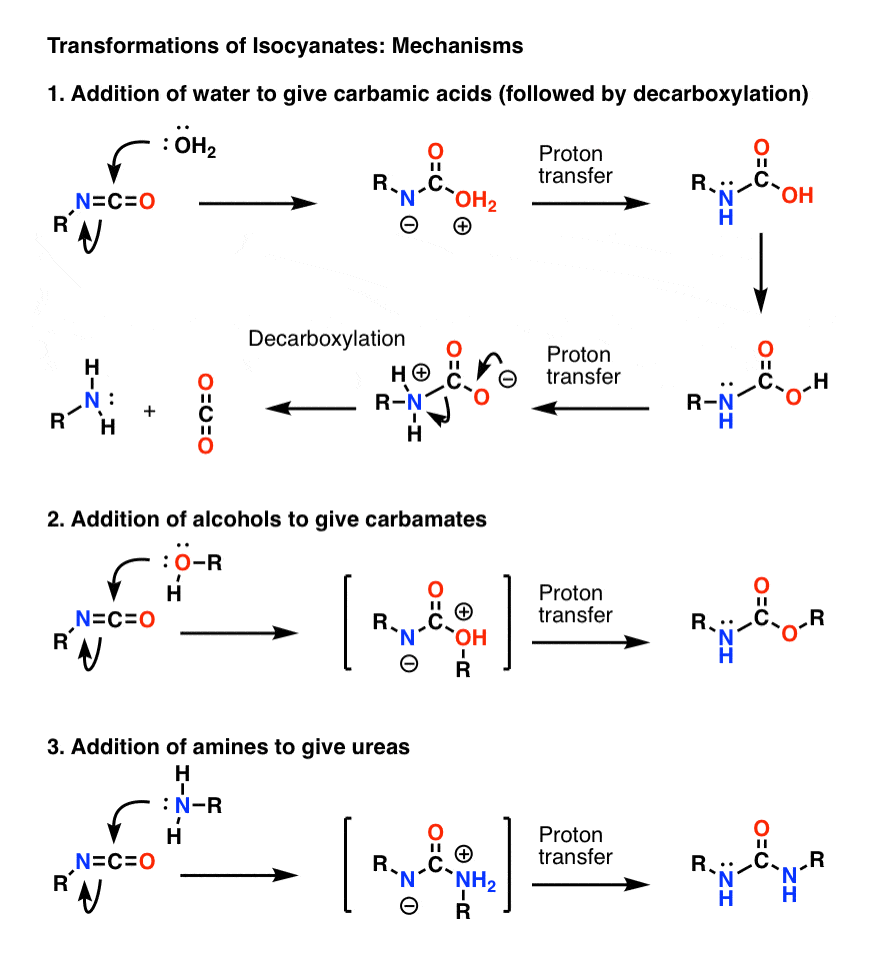
Note 3. The Beckmann, Wolff, and other rearrangements share a similar step
But wait, there’s more!
There’s a 1,2-shift with loss of a leaving group in the Beckmann rearrangement. The key step is essentially the same as we saw in the Hofmann and Curtius.
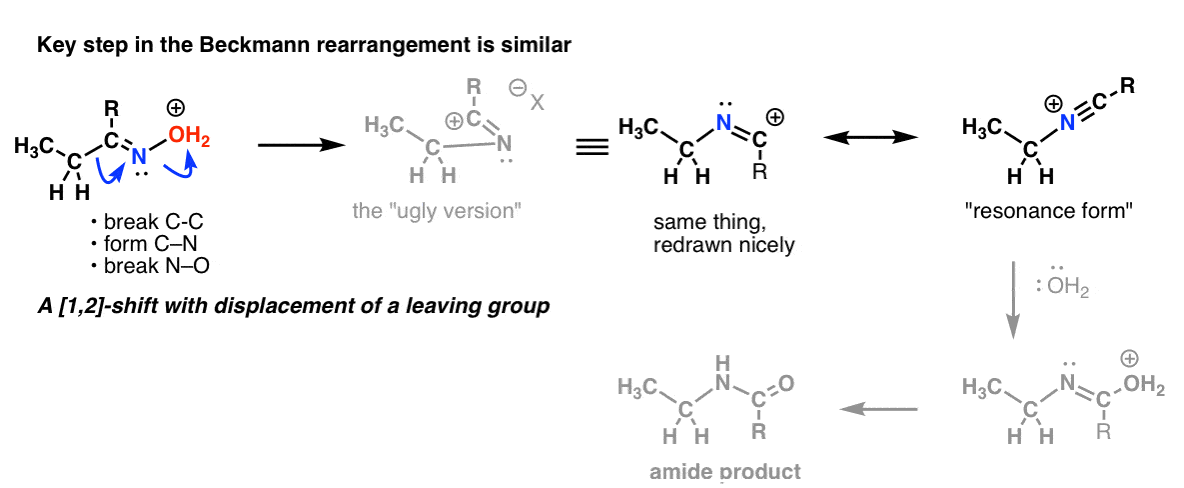
And in the Wolff rearrangement, which is commonly also covered, you might also recognize the same key step.
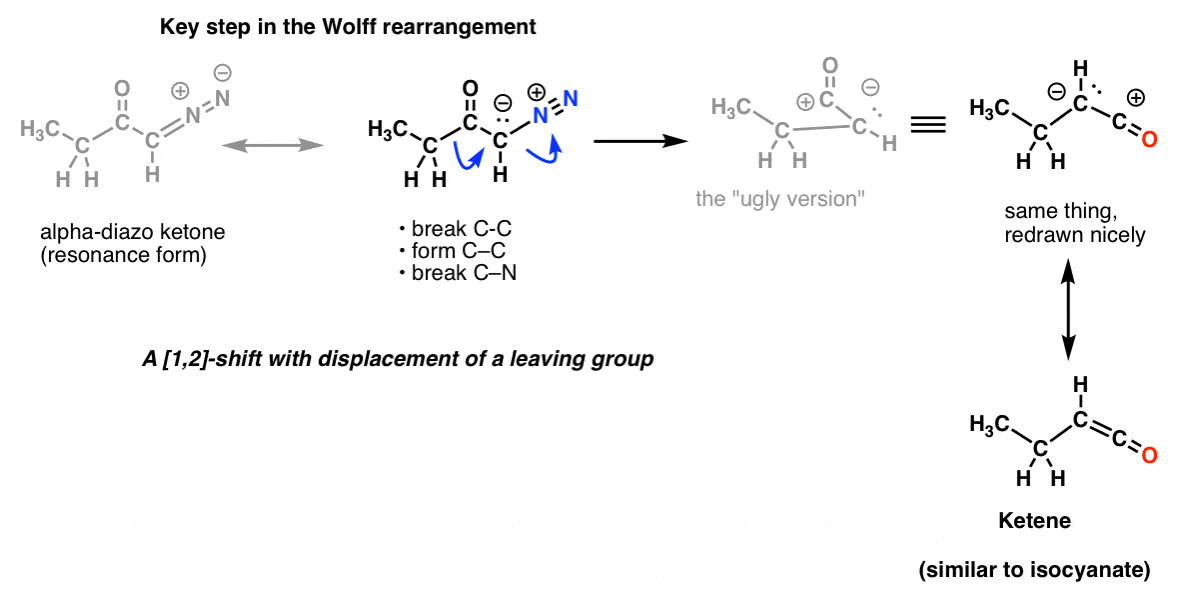
And that’s not all! There’s a reaction called the Schmidt rearrangement, which is like the Curtius, but comes from adding HN3 to an acyl chloride (or carboxylic acid). And there’s another one called the Lossen rearrangement that occurs with hydroxyamic acids. No prizes for guessing the key step in those two processes. And we haven’t even mentioned the Baeyer-Villiger, which doesn’t involve nitrogen, but is pretty much the same type of process.
When I learned the hydroboration-oxidation step in Org 1, many moons ago, I certainly never expected that I would see the same reaction pattern repeat itself in so many different guises.
The bottom line is that there are a lot of reactions that go by different names that proceed through the same mechanistic process. This highlights the importance of learning the key patterns in organic chemistry, because they sure do repeat themselves a lot.
Quiz Yourself!
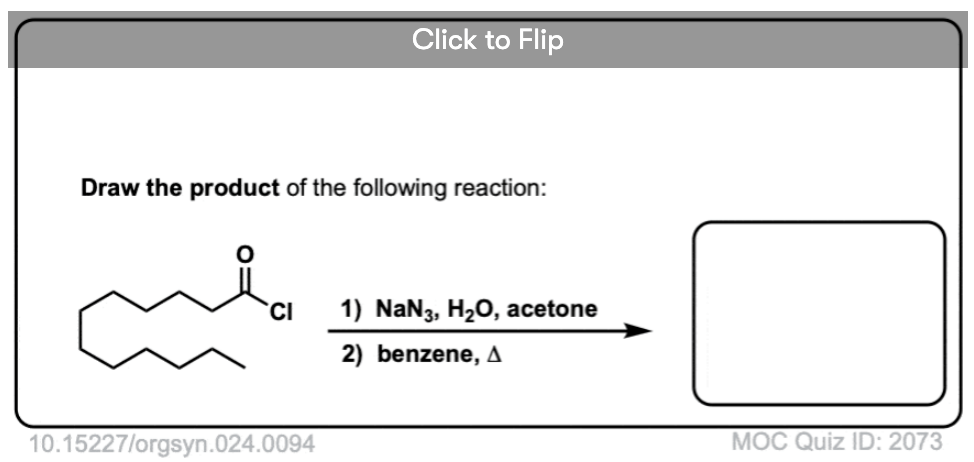
Become a MOC member to see the clickable quiz with answers on the back.

Become a MOC member to see the clickable quiz with answers on the back.

Become a MOC member to see the clickable quiz with answers on the back.

Become a MOC member to see the clickable quiz with answers on the back.

Become a MOC member to see the clickable quiz with answers on the back.
(Advanced) References and Further Reading
- Ueber die Einwirkung des Broms in alkalischer Lösung auf Amide
W. Hofmann
Chem. Ber. 1881, 14, 2725-2736
DOI: 10.1002/cber.188101402242
Original paper by A. W. Hofmann (who was a very productive chemist and has his name attributed to many other transformations) on the degradation of amides to primary amines. - A Mild and Efficient Modified Hofmann Rearrangement
Xicai Huang, Mehran Seid, and Jeffrey W. Keillor
The Journal of Organic Chemistry 1997, 62 (21), 7495-7496
DOI:10.1021/jo9708553
This is a modified Hofmann Rearrangement carried out in methanol – in this case, the intermediate carbamic acid can react with the methanol solvent to produce methyl carbamates in good yield. - METHYL CARBAMATE FORMATION VIA MODIFIED HOFMANN REARRANGEMENT REACTIONS: METHYL N-(p-METHOXYPHENYL)CARBAMATE
Jeffrey W. Keillor and Xicai Huang
Org. Synth. 2002, 78, 234
DOI: 10.15227/orgsyn.078.0234
A reliable and independently tested procedure for the modified Hofmann Rearrangement in Ref #2. - The Hofmann Reaction
Wallis, Everett L.; Lane, John F.
Org. React. 1946, 3, 267-306
DOI: 10.1002/0471264180.or003.07
An old but comprehensive (for its time) review on the Hofmann reaction (the amide to amine reaction, not to be confused with his other reactions). - Notes – A Re-examination of the Limitations of the Hofmann Reaction
Ernest Magnien and Richard Baltzly
The Journal of Organic Chemistry 1958, 23 (12), 2029-2032
DOI:10.1021/jo01106a630
This is an interesting paper where the authors have attempted to extend the scope of the Hofmann rearrangement beyond what was described in the original paper by carefully adjusting the reaction conditions. - 20. Hydrazide und Azide organischer Säuren
Curtius, T. I. Abhandlung.
Journal Für Praktische Chemie, 50(1), 275–294. (1894).
DOI: 1002/prac.18940500125 - Ueber Stickstoffwasserstoffsäure (Azoimid) N3H.
Curtius, T.
Berichte Der Deutschen Chemischen Gesellschaft, 23(2), 3023–3033.(1890).
DOI: 1002/cber.189002302232
First papers by Theodore Curtius describing the reactivity of acyl hyrazides and acyl azides. - The Curtius Reaction
Smith, P. A. S.
Org. React. 1946, 3, 336
DOI: 10.1002/0471264180.or003.09
An old but comprehensive review of the Curtius reaction, which includes the history of the discovery of this rearrangement, substrate scope, limitations, comparison to other similar reactions, and experimental procedures. - UNDECYL ISOCYANATE
F. H. Allen and Alan Bell
Org. Synth. 1944, 24, 94
DOI: 10.15227/orgsyn.024.0094
An old but reproducible and tested procedure for synthesizing isocyanates through the Curtius Rearrangement. - An Expedient Protecting-Group-Free Total Synthesis of (±)-Dievodiamine
William P. Unsworth, Christiana Kitsiou, and Richard J. K. Taylor
Organic Letters 2013 15 (13), 3302-3305
DOI: 1021/ol4013469
The first step in this total synthesis uses a Curtius rearrangement to effect an intramolecular cyclization of the indole-substituted carboxylic acid. - Synthetic methods and reactions. 121. Zinc iodide catalyzed preparation of aroyl azides from aroyl chlorides and trimethylsilyl azide
K. Surya Prakash, Pradeep S. Iyer, Massoud Arvanaghi, and George A. Olah
The Journal of Organic Chemistry 1983 48 (19), 3358-3359
DOI: 10.1021/jo00167a051
A convenient procedure for preparing aromatic aryl azides from Nobel Laureate Prof. George A. Olah. These can then be used for Curtius rearrangements.
00 General Chemistry Review
01 Bonding, Structure, and Resonance
- How Do We Know Methane (CH4) Is Tetrahedral?
- Hybrid Orbitals and Hybridization
- How To Determine Hybridization: A Shortcut
- Orbital Hybridization And Bond Strengths
- Sigma bonds come in six varieties: Pi bonds come in one
- A Key Skill: How to Calculate Formal Charge
- The Four Intermolecular Forces and How They Affect Boiling Points
- 3 Trends That Affect Boiling Points
- How To Use Electronegativity To Determine Electron Density (and why NOT to trust formal charge)
- Introduction to Resonance
- How To Use Curved Arrows To Interchange Resonance Forms
- Evaluating Resonance Forms (1) - The Rule of Least Charges
- How To Find The Best Resonance Structure By Applying Electronegativity
- Evaluating Resonance Structures With Negative Charges
- Evaluating Resonance Structures With Positive Charge
- Exploring Resonance: Pi-Donation
- Exploring Resonance: Pi-acceptors
- In Summary: Evaluating Resonance Structures
- Drawing Resonance Structures: 3 Common Mistakes To Avoid
- How to apply electronegativity and resonance to understand reactivity
- Bond Hybridization Practice
- Structure and Bonding Practice Quizzes
- Resonance Structures Practice
02 Acid Base Reactions
- Introduction to Acid-Base Reactions
- Acid Base Reactions In Organic Chemistry
- The Stronger The Acid, The Weaker The Conjugate Base
- Walkthrough of Acid-Base Reactions (3) - Acidity Trends
- Five Key Factors That Influence Acidity
- Acid-Base Reactions: Introducing Ka and pKa
- How to Use a pKa Table
- The pKa Table Is Your Friend
- A Handy Rule of Thumb for Acid-Base Reactions
- Acid Base Reactions Are Fast
- pKa Values Span 60 Orders Of Magnitude
- How Protonation and Deprotonation Affect Reactivity
- Acid Base Practice Problems
03 Alkanes and Nomenclature
- Meet the (Most Important) Functional Groups
- Condensed Formulas: Deciphering What the Brackets Mean
- Hidden Hydrogens, Hidden Lone Pairs, Hidden Counterions
- Don't Be Futyl, Learn The Butyls
- Primary, Secondary, Tertiary, Quaternary In Organic Chemistry
- Branching, and Its Affect On Melting and Boiling Points
- The Many, Many Ways of Drawing Butane
- Wedge And Dash Convention For Tetrahedral Carbon
- Common Mistakes in Organic Chemistry: Pentavalent Carbon
- Table of Functional Group Priorities for Nomenclature
- Summary Sheet - Alkane Nomenclature
- Organic Chemistry IUPAC Nomenclature Demystified With A Simple Puzzle Piece Approach
- Boiling Point Quizzes
- Organic Chemistry Nomenclature Quizzes
04 Conformations and Cycloalkanes
- Staggered vs Eclipsed Conformations of Ethane
- Conformational Isomers of Propane
- Newman Projection of Butane (and Gauche Conformation)
- Introduction to Cycloalkanes
- Geometric Isomers In Small Rings: Cis And Trans Cycloalkanes
- Calculation of Ring Strain In Cycloalkanes
- Cycloalkanes - Ring Strain In Cyclopropane And Cyclobutane
- Cyclohexane Conformations
- Cyclohexane Chair Conformation: An Aerial Tour
- How To Draw The Cyclohexane Chair Conformation
- The Cyclohexane Chair Flip
- The Cyclohexane Chair Flip - Energy Diagram
- Substituted Cyclohexanes - Axial vs Equatorial
- Ranking The Bulkiness Of Substituents On Cyclohexanes: "A-Values"
- Cyclohexane Chair Conformation Stability: Which One Is Lower Energy?
- Fused Rings - Cis-Decalin and Trans-Decalin
- Naming Bicyclic Compounds - Fused, Bridged, and Spiro
- Bredt's Rule (And Summary of Cycloalkanes)
- Newman Projection Practice
- Cycloalkanes Practice Problems
05 A Primer On Organic Reactions
- The Most Important Question To Ask When Learning a New Reaction
- Curved Arrows (for reactions)
- Nucleophiles and Electrophiles
- The Three Classes of Nucleophiles
- Nucleophilicity vs. Basicity
- What Makes A Good Nucleophile?
- What Makes A Good Leaving Group?
- 3 Factors That Stabilize Carbocations
- Equilibrium and Energy Relationships
- 7 Factors that stabilize negative charge in organic chemistry
- 7 Factors That Stabilize Positive Charge in Organic Chemistry
- What's a Transition State?
- Hammond's Postulate
- Learning Organic Chemistry Reactions: A Checklist (PDF)
- Introduction to Oxidative Cleavage Reactions
06 Free Radical Reactions
- Free Radical Reactions
- 3 Factors That Stabilize Free Radicals
- Bond Strengths And Radical Stability
- Free Radical Initiation: Why Is "Light" Or "Heat" Required?
- Initiation, Propagation, Termination
- Monochlorination Products Of Propane, Pentane, And Other Alkanes
- Selectivity In Free Radical Reactions
- Selectivity in Free Radical Reactions: Bromination vs. Chlorination
- Halogenation At Tiffany's
- Allylic Bromination
- Bonus Topic: Allylic Rearrangements
- In Summary: Free Radicals
- Synthesis (2) - Reactions of Alkanes
- Free Radicals Practice Quizzes
07 Stereochemistry and Chirality
- Types of Isomers: Constitutional Isomers, Stereoisomers, Enantiomers, and Diastereomers
- How To Draw The Enantiomer Of A Chiral Molecule
- How To Draw A Bond Rotation
- Introduction to Assigning (R) and (S): The Cahn-Ingold-Prelog Rules
- Assigning Cahn-Ingold-Prelog (CIP) Priorities (2) - The Method of Dots
- Enantiomers vs Diastereomers vs The Same? Two Methods For Solving Problems
- Assigning R/S To Newman Projections (And Converting Newman To Line Diagrams)
- How To Determine R and S Configurations On A Fischer Projection
- The Meso Trap
- Optical Rotation, Optical Activity, and Specific Rotation
- Optical Purity and Enantiomeric Excess
- What's a Racemic Mixture?
- Chiral Allenes And Chiral Axes
- Stereochemistry Practice Problems and Quizzes
08 Substitution Reactions
- Nucleophilic Substitution Reactions - Introduction
- Two Types of Nucleophilic Substitution Reactions
- The SN2 Mechanism
- Why the SN2 Reaction Is Powerful
- The SN1 Mechanism
- The Conjugate Acid Is A Better Leaving Group
- Comparing the SN1 and SN2 Reactions
- Polar Protic? Polar Aprotic? Nonpolar? All About Solvents
- Steric Hindrance is Like a Fat Goalie
- Common Blind Spot: Intramolecular Reactions
- Substitution Practice - SN1
- Substitution Practice - SN2
09 Elimination Reactions
- Elimination Reactions (1): Introduction And The Key Pattern
- Elimination Reactions (2): The Zaitsev Rule
- Elimination Reactions Are Favored By Heat
- Two Elimination Reaction Patterns
- The E1 Reaction
- The E2 Mechanism
- E1 vs E2: Comparing the E1 and E2 Reactions
- Antiperiplanar Relationships: The E2 Reaction and Cyclohexane Rings
- Bulky Bases in Elimination Reactions
- Comparing the E1 vs SN1 Reactions
- Elimination (E1) Reactions With Rearrangements
- E1cB - Elimination (Unimolecular) Conjugate Base
- Elimination (E1) Practice Problems And Solutions
- Elimination (E2) Practice Problems and Solutions
10 Rearrangements
11 SN1/SN2/E1/E2 Decision
- Identifying Where Substitution and Elimination Reactions Happen
- Deciding SN1/SN2/E1/E2 (1) - The Substrate
- Deciding SN1/SN2/E1/E2 (2) - The Nucleophile/Base
- SN1 vs E1 and SN2 vs E2 : The Temperature
- Deciding SN1/SN2/E1/E2 - The Solvent
- Wrapup: The Key Factors For Determining SN1/SN2/E1/E2
- Alkyl Halide Reaction Map And Summary
- SN1 SN2 E1 E2 Practice Problems
12 Alkene Reactions
- E and Z Notation For Alkenes (+ Cis/Trans)
- Alkene Stability
- Alkene Addition Reactions: "Regioselectivity" and "Stereoselectivity" (Syn/Anti)
- Stereoselective and Stereospecific Reactions
- Hydrohalogenation of Alkenes and Markovnikov's Rule
- Hydration of Alkenes With Aqueous Acid
- Rearrangements in Alkene Addition Reactions
- Halogenation of Alkenes and Halohydrin Formation
- Oxymercuration Demercuration of Alkenes
- Hydroboration Oxidation of Alkenes
- m-CPBA (meta-chloroperoxybenzoic acid)
- OsO4 (Osmium Tetroxide) for Dihydroxylation of Alkenes
- Palladium on Carbon (Pd/C) for Catalytic Hydrogenation of Alkenes
- Cyclopropanation of Alkenes
- A Fourth Alkene Addition Pattern - Free Radical Addition
- Alkene Reactions: Ozonolysis
- Summary: Three Key Families Of Alkene Reaction Mechanisms
- Synthesis (4) - Alkene Reaction Map, Including Alkyl Halide Reactions
- Alkene Reactions Practice Problems
13 Alkyne Reactions
- Acetylides from Alkynes, And Substitution Reactions of Acetylides
- Partial Reduction of Alkynes With Lindlar's Catalyst
- Partial Reduction of Alkynes With Na/NH3 To Obtain Trans Alkenes
- Alkyne Hydroboration With "R2BH"
- Hydration and Oxymercuration of Alkynes
- Hydrohalogenation of Alkynes
- Alkyne Halogenation: Bromination and Chlorination of Alkynes
- Oxidation of Alkynes With O3 and KMnO4
- Alkenes To Alkynes Via Halogenation And Elimination Reactions
- Alkynes Are A Blank Canvas
- Synthesis (5) - Reactions of Alkynes
- Alkyne Reactions Practice Problems With Answers
14 Alcohols, Epoxides and Ethers
- Alcohols - Nomenclature and Properties
- Alcohols Can Act As Acids Or Bases (And Why It Matters)
- Alcohols - Acidity and Basicity
- The Williamson Ether Synthesis
- Ethers From Alkenes, Tertiary Alkyl Halides and Alkoxymercuration
- Alcohols To Ethers via Acid Catalysis
- Cleavage Of Ethers With Acid
- Epoxides - The Outlier Of The Ether Family
- Opening of Epoxides With Acid
- Epoxide Ring Opening With Base
- Making Alkyl Halides From Alcohols
- Tosylates And Mesylates
- PBr3 and SOCl2
- Elimination Reactions of Alcohols
- Elimination of Alcohols To Alkenes With POCl3
- Alcohol Oxidation: "Strong" and "Weak" Oxidants
- Demystifying The Mechanisms of Alcohol Oxidations
- Protecting Groups For Alcohols
- Thiols And Thioethers
- Calculating the oxidation state of a carbon
- Oxidation and Reduction in Organic Chemistry
- Oxidation Ladders
- SOCl2 Mechanism For Alcohols To Alkyl Halides: SN2 versus SNi
- Alcohol Reactions Roadmap (PDF)
- Alcohol Reaction Practice Problems
- Epoxide Reaction Quizzes
- Oxidation and Reduction Practice Quizzes
15 Organometallics
- What's An Organometallic?
- Formation of Grignard and Organolithium Reagents
- Organometallics Are Strong Bases
- Reactions of Grignard Reagents
- Protecting Groups In Grignard Reactions
- Synthesis Problems Involving Grignard Reagents
- Grignard Reactions And Synthesis (2)
- Organocuprates (Gilman Reagents): How They're Made
- Gilman Reagents (Organocuprates): What They're Used For
- The Heck, Suzuki, and Olefin Metathesis Reactions (And Why They Don't Belong In Most Introductory Organic Chemistry Courses)
- Reaction Map: Reactions of Organometallics
- Grignard Practice Problems
16 Spectroscopy
- Degrees of Unsaturation (or IHD, Index of Hydrogen Deficiency)
- Conjugation And Color (+ How Bleach Works)
- Introduction To UV-Vis Spectroscopy
- UV-Vis Spectroscopy: Absorbance of Carbonyls
- UV-Vis Spectroscopy: Practice Questions
- Bond Vibrations, Infrared Spectroscopy, and the "Ball and Spring" Model
- Infrared Spectroscopy: A Quick Primer On Interpreting Spectra
- IR Spectroscopy: 4 Practice Problems
- 1H NMR: How Many Signals?
- Homotopic, Enantiotopic, Diastereotopic
- Diastereotopic Protons in 1H NMR Spectroscopy: Examples
- 13-C NMR - How Many Signals
- Liquid Gold: Pheromones In Doe Urine
- Natural Product Isolation (1) - Extraction
- Natural Product Isolation (2) - Purification Techniques, An Overview
- Structure Determination Case Study: Deer Tarsal Gland Pheromone
17 Dienes and MO Theory
- What To Expect In Organic Chemistry 2
- Are these molecules conjugated?
- Conjugation And Resonance In Organic Chemistry
- Bonding And Antibonding Pi Orbitals
- Molecular Orbitals of The Allyl Cation, Allyl Radical, and Allyl Anion
- Pi Molecular Orbitals of Butadiene
- Reactions of Dienes: 1,2 and 1,4 Addition
- Thermodynamic and Kinetic Products
- More On 1,2 and 1,4 Additions To Dienes
- s-cis and s-trans
- The Diels-Alder Reaction
- Cyclic Dienes and Dienophiles in the Diels-Alder Reaction
- Stereochemistry of the Diels-Alder Reaction
- Exo vs Endo Products In The Diels Alder: How To Tell Them Apart
- HOMO and LUMO In the Diels Alder Reaction
- Why Are Endo vs Exo Products Favored in the Diels-Alder Reaction?
- Diels-Alder Reaction: Kinetic and Thermodynamic Control
- The Retro Diels-Alder Reaction
- The Intramolecular Diels Alder Reaction
- Regiochemistry In The Diels-Alder Reaction
- The Cope and Claisen Rearrangements
- Electrocyclic Reactions
- Electrocyclic Ring Opening And Closure (2) - Six (or Eight) Pi Electrons
- Diels Alder Practice Problems
- Molecular Orbital Theory Practice
18 Aromaticity
- Introduction To Aromaticity
- Rules For Aromaticity
- Huckel's Rule: What Does 4n+2 Mean?
- Aromatic, Non-Aromatic, or Antiaromatic? Some Practice Problems
- Antiaromatic Compounds and Antiaromaticity
- The Pi Molecular Orbitals of Benzene
- The Pi Molecular Orbitals of Cyclobutadiene
- Frost Circles
- Aromaticity Practice Quizzes
19 Reactions of Aromatic Molecules
- Electrophilic Aromatic Substitution: Introduction
- Activating and Deactivating Groups In Electrophilic Aromatic Substitution
- Electrophilic Aromatic Substitution - The Mechanism
- Ortho-, Para- and Meta- Directors in Electrophilic Aromatic Substitution
- Understanding Ortho, Para, and Meta Directors
- Why are halogens ortho- para- directors?
- Disubstituted Benzenes: The Strongest Electron-Donor "Wins"
- Electrophilic Aromatic Substitutions (1) - Halogenation of Benzene
- Electrophilic Aromatic Substitutions (2) - Nitration and Sulfonation
- EAS Reactions (3) - Friedel-Crafts Acylation and Friedel-Crafts Alkylation
- Intramolecular Friedel-Crafts Reactions
- Nucleophilic Aromatic Substitution (NAS)
- Nucleophilic Aromatic Substitution (2) - The Benzyne Mechanism
- Reactions on the "Benzylic" Carbon: Bromination And Oxidation
- The Wolff-Kishner, Clemmensen, And Other Carbonyl Reductions
- More Reactions on the Aromatic Sidechain: Reduction of Nitro Groups and the Baeyer Villiger
- Aromatic Synthesis (1) - "Order Of Operations"
- Synthesis of Benzene Derivatives (2) - Polarity Reversal
- Aromatic Synthesis (3) - Sulfonyl Blocking Groups
- Birch Reduction
- Synthesis (7): Reaction Map of Benzene and Related Aromatic Compounds
- Aromatic Reactions and Synthesis Practice
- Electrophilic Aromatic Substitution Practice Problems
20 Aldehydes and Ketones
- What's The Alpha Carbon In Carbonyl Compounds?
- Nucleophilic Addition To Carbonyls
- Aldehydes and Ketones: 14 Reactions With The Same Mechanism
- Sodium Borohydride (NaBH4) Reduction of Aldehydes and Ketones
- Grignard Reagents For Addition To Aldehydes and Ketones
- Wittig Reaction
- Hydrates, Hemiacetals, and Acetals
- Imines - Properties, Formation, Reactions, and Mechanisms
- All About Enamines
- Breaking Down Carbonyl Reaction Mechanisms: Reactions of Anionic Nucleophiles (Part 2)
- Aldehydes Ketones Reaction Practice
21 Carboxylic Acid Derivatives
- Nucleophilic Acyl Substitution (With Negatively Charged Nucleophiles)
- Addition-Elimination Mechanisms With Neutral Nucleophiles (Including Acid Catalysis)
- Basic Hydrolysis of Esters - Saponification
- Transesterification
- Proton Transfer
- Fischer Esterification - Carboxylic Acid to Ester Under Acidic Conditions
- Lithium Aluminum Hydride (LiAlH4) For Reduction of Carboxylic Acid Derivatives
- LiAlH[Ot-Bu]3 For The Reduction of Acid Halides To Aldehydes
- Di-isobutyl Aluminum Hydride (DIBAL) For The Partial Reduction of Esters and Nitriles
- Amide Hydrolysis
- Thionyl Chloride (SOCl2) And Conversion of Carboxylic Acids to Acid Halides
- Diazomethane (CH2N2)
- Carbonyl Chemistry: Learn Six Mechanisms For the Price Of One
- Making Music With Mechanisms (PADPED)
- Carboxylic Acid Derivatives Practice Questions
22 Enols and Enolates
- Keto-Enol Tautomerism
- Enolates - Formation, Stability, and Simple Reactions
- Kinetic Versus Thermodynamic Enolates
- Aldol Addition and Condensation Reactions
- Reactions of Enols - Acid-Catalyzed Aldol, Halogenation, and Mannich Reactions
- Claisen Condensation and Dieckmann Condensation
- Decarboxylation
- The Malonic Ester and Acetoacetic Ester Synthesis
- The Michael Addition Reaction and Conjugate Addition
- The Robinson Annulation
- Haloform Reaction
- The Hell–Volhard–Zelinsky Reaction
- Enols and Enolates Practice Quizzes
23 Amines
- The Amide Functional Group: Properties, Synthesis, and Nomenclature
- Basicity of Amines And pKaH
- 5 Key Basicity Trends of Amines
- The Mesomeric Effect And Aromatic Amines
- Nucleophilicity of Amines
- Alkylation of Amines (Sucks!)
- Reductive Amination
- The Gabriel Synthesis
- Some Reactions of Azides
- The Hofmann Elimination
- The Hofmann and Curtius Rearrangements
- The Cope Elimination
- Protecting Groups for Amines - Carbamates
- The Strecker Synthesis of Amino Acids
- Introduction to Peptide Synthesis
- Reactions of Diazonium Salts: Sandmeyer and Related Reactions
- Amine Practice Questions
24 Carbohydrates
- D and L Notation For Sugars
- Pyranoses and Furanoses: Ring-Chain Tautomerism In Sugars
- What is Mutarotation?
- Reducing Sugars
- The Big Damn Post Of Carbohydrate-Related Chemistry Definitions
- The Haworth Projection
- Converting a Fischer Projection To A Haworth (And Vice Versa)
- Reactions of Sugars: Glycosylation and Protection
- The Ruff Degradation and Kiliani-Fischer Synthesis
- Isoelectric Points of Amino Acids (and How To Calculate Them)
- Carbohydrates Practice
- Amino Acid Quizzes
25 Fun and Miscellaneous
- A Gallery of Some Interesting Molecules From Nature
- Screw Organic Chemistry, I'm Just Going To Write About Cats
- On Cats, Part 1: Conformations and Configurations
- On Cats, Part 2: Cat Line Diagrams
- On Cats, Part 4: Enantiocats
- On Cats, Part 6: Stereocenters
- Organic Chemistry Is Shit
- The Organic Chemistry Behind "The Pill"
- Maybe they should call them, "Formal Wins" ?
- Why Do Organic Chemists Use Kilocalories?
- The Principle of Least Effort
- Organic Chemistry GIFS - Resonance Forms
- Reproducibility In Organic Chemistry
- What Holds The Nucleus Together?
- How Reactions Are Like Music
- Organic Chemistry and the New MCAT
26 Organic Chemistry Tips and Tricks
- Common Mistakes: Formal Charges Can Mislead
- Partial Charges Give Clues About Electron Flow
- Draw The Ugly Version First
- Organic Chemistry Study Tips: Learn the Trends
- The 8 Types of Arrows In Organic Chemistry, Explained
- Top 10 Skills To Master Before An Organic Chemistry 2 Final
- Common Mistakes with Carbonyls: Carboxylic Acids... Are Acids!
- Planning Organic Synthesis With "Reaction Maps"
- Alkene Addition Pattern #1: The "Carbocation Pathway"
- Alkene Addition Pattern #2: The "Three-Membered Ring" Pathway
- Alkene Addition Pattern #3: The "Concerted" Pathway
- Number Your Carbons!
- The 4 Major Classes of Reactions in Org 1
- How (and why) electrons flow
- Grossman's Rule
- Three Exam Tips
- A 3-Step Method For Thinking Through Synthesis Problems
- Putting It Together
- Putting Diels-Alder Products in Perspective
- The Ups and Downs of Cyclohexanes
- The Most Annoying Exceptions in Org 1 (Part 1)
- The Most Annoying Exceptions in Org 1 (Part 2)
- The Marriage May Be Bad, But the Divorce Still Costs Money
- 9 Nomenclature Conventions To Know
- Nucleophile attacks Electrophile
27 Case Studies of Successful O-Chem Students
- Success Stories: How Corina Got The The "Hard" Professor - And Got An A+ Anyway
- How Helena Aced Organic Chemistry
- From a "Drop" To B+ in Org 2 – How A Hard Working Student Turned It Around
- How Serge Aced Organic Chemistry
- Success Stories: How Zach Aced Organic Chemistry 1
- Success Stories: How Kari Went From C– to B+
- How Esther Bounced Back From a "C" To Get A's In Organic Chemistry 1 And 2
- How Tyrell Got The Highest Grade In Her Organic Chemistry Course
- This Is Why Students Use Flashcards
- Success Stories: How Stu Aced Organic Chemistry
- How John Pulled Up His Organic Chemistry Exam Grades
- Success Stories: How Nathan Aced Organic Chemistry (Without It Taking Over His Life)
- How Chris Aced Org 1 and Org 2
- Interview: How Jay Got an A+ In Organic Chemistry
- How to Do Well in Organic Chemistry: One Student's Advice
- "America's Top TA" Shares His Secrets For Teaching O-Chem
- "Organic Chemistry Is Like..." - A Few Metaphors
- How To Do Well In Organic Chemistry: Advice From A Tutor
- Guest post: "I went from being afraid of tests to actually looking forward to them".
Your first summary figure shows the Curtius product resulting from an addition of an alcohol to the isocyanate as an ester (though it is titled carbamate). I think you are missing a nitrogen in the structure.
Fixed. Grateful for the spot. Thank you very much.
Am I mistaken, but in line two of the first box, the product as drawn is an ester and not the Carbamate as claimed?
R(C=O)OR is not RN(C=O)OR
You are correct. Thank you very much for spotting this, it’s fixed.
Is it possible to convert an amide into an amine just like Hoffmann rearrangement using NaI instead of NaBr?
We don’t use NaI or NaBr for the Hofmann rearrangement because they are not electrophilic sources of halogen. We use Br2 or other sources of electrophilic Br or Cl. I am not aware of an example of using I2 or similar electrophilic I(+) reagents for doing the Hofmann but there is no reason I can see as to why it would not work, although why you’d prefer to use I versus Br I’m not sure
Sir, Can Urea undergo Hofmann Rearrangement?
Very nice explanation
But sir please help me with this
Can you please tell me that after the formation of isocyanate, the intermediate compound takes an OH- and the product is Primary amine thats ok but how is carbonate ion forming?
Sir please help
Spontaneous decarboxylation, just like how carbonic acid will spontaneously decarboxylate.
Sorry what happens if I heat acyl azide with aq KOH and Br2?
Not sure. Heating with Br2 and KOH is usually what you’d do with an amide (Hofmann rearrangement conditions), not an acyl azide. Eventually the heat should lead to a Curtius rearrangement, but I’m not sure what the effect would be. There’s no reason to add Br2 and KOH to an acyl azide.
What happenes when an isocyanate is heated with aq KOH+Br2?
Hi, there appears to be a “typo” in the Part 1 image for the acyl azide: the “plus” charge should be on the middle nitrogen instead of the nitrogen bonded to the oxygen? Googling “acyl azide” seems to confirm what the correct charge distribution for acyl azide looks like.
Shoot. You are correct. Thanks for spotting, fixed.
Hi James,
Thank you for sharing such a great explanation. However, I am wondering is it possible to have some change in an amide. Instead of CO-NH2 if we use CO-NHR will it result in the same rearrangement?
Thanks in advance James, you are the best!
Great question. You need a primary amide. If you try to perform it with a secondary amide you just end up replacing N-H with N-Br and it stops there, since there’s no N-H for the HO- to deprotonate and no driving force for the reaction.
I’ve got a fairly benign question that I’m unable to find an answer to, but it’s burning enough that it’s still bugging me:
In the Hofmann Rearrangement, you show the amide attacking Br2, followed by de-protonation via MOH. However, my professor showed the mechanism such that the de-protonation occurs first. The pKa’s for the acids and conjugates don’t seem to support this approach though (at least at STP). I could be missing something though, what say you? Any insight?
Warmest regards,
Hi Ben
It’s totally possible to deprotonate the amide first and then add Br2. In fact it will be more nucleophililc than would be the neutral amide.
The pKa of the amide is about 17, comparable to that of an alcohol, so it’s very reasonable.
James
Thanks for taking time to respond. I had it in mind that the pKa of amides was approximately 25, but it seems I wasn’t accounting for the solvent since I got this value from the Bordwell table (in DMSO).
Warmest regards,
Ben
Ha, very true statement about there being no narrative behind coverage of amines. I tend to frame them first as nucleophilic at nitrogen (it’s all about nitrogen’s “angry” lone pair), then transition to things that happen once the nitrogen gets protonated/alkylated/”electrophile”-ated. But things get complicated after coordination of an electrophile to nitrogen, and the scope of electrophiles is broad…as these rearrangements suggest. One of the issues is that amines are readily transformed into functional groups that look very little like amines, such as isocyanates.
I’d say the typical approach to amines is ripe for change. :-)